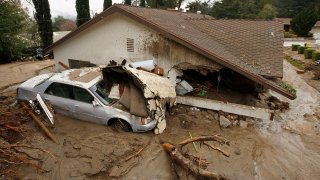
The danger from wildfires doesn’t end when the flames go out. Even one modest rainfall after a fire can cause a deadly landslide.
When fire moves through a watershed, it creates waxy seals that don't allow water to penetrate the soil anymore. Instead, the rainwater runs off the soil surface causing debris flows, which are fast-moving landslides that usually start on steep hills and accelerate as they move.
The first storm events that strike a burn area are the most critical. Hillsides burned by recent wildfires have the threat of mud flow and erosion issues with the monsoon flow in our area.
Historic California Floods in Photos
Start thinking ahead to prepare.
Be prepared to evacuate. Listen to local authorities and leave if you are told to evacuate. Decide in advance where you would go in case you can’t return home for weeks or months.
What to Inspect
Look around your home and property for landslide warning signs.
- Cracks or bumps appear on hill slopes, ground or roads
- Water or saturated ground in areas not normally wet
- Evidence of slow, downhill movement of rock and soil
- Tilted trees, poles, decks, patios, fences or walls
- Doors and windows stick or cracks appear on walls, etc.
During a mudflow or landslide, be aware of the following.
- Listen for trees cracking, rocks banging together or water flowing rapidly (especially if near a stream or river)—debris flow may be close by.
- Move it! Whether you are in a vehicle, outside or in your home—get to safer ground.
- Be small. If there is no way to escape, curl into a tight ball and protect your head the best you can.
After a landslide or erosion flow, be aware of the following.
- Flooding—Usually occurs after landslides or debris flow
- Damaged areas—Roadways and bridges may be buried, washed out or weakened—and water, gas and sewer lines may be broken
- Downed power lines—Report them to power company
- Inspect—Look for damage around home and property and watch for new landslide warning signs:
- Check foundation, chimney, garage and other structures.
- Report any broken utility lines or damaged roads to local authorities.
- Watch for tilted trees, poles, decks, patios, fences or walls.
- Notice doors or windows stick, cracks appear, etc.
Flash floods are the number one storm-related killed in the United States. In the last three years, flooding has taken the lives of more than 100 people in the U.S. each year, and the numbers are growing as climate change increases the number of days with extremely heavy precipitation.
Wildfires
Today's breaking news on wildfires in California, SoCal and Los Angeles. Here is the latest on fires now, including breaking developments, public safety information, maps, video and longterm outlooks.
Eighty percent of flood deaths occur in vehicles, and most happen when drivers make a single, fatal mistake – trying to navigate through floodwaters.
Do you know what 6 – 12 and 18 add up to? Danger.
Six inches of moving water can knock you off your feet.
Twelve inches of moving water can move a small car.
Eighteen inches of moving water can move a large vehicle, truck or SUV.
Sam DiGiovanna is a 35-year fire service veteran. He started with the Los Angeles County Fire Department, served as Fire Chief at the Monrovia Fire Department and currently serves as Chief at the Verdugo Fire Academy in Glendale.



